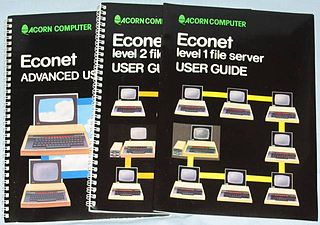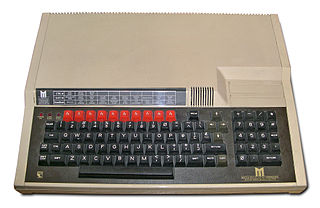Related Research Articles

The Acorn Electron is a budget version of the BBC Micro educational/home computer introduced by Acorn Computers Ltd on 25 August 1983. It has 32 kilobytes of RAM, and its ROM includes BBC BASIC v2 along with its operating system.

BBC BASIC is a version of the BASIC programming language released in 1981 as the native programming language for the BBC Micro home/personal computer, providing a standardized language for a UK computer literacy project of the BBC. It was written mainly by Sophie Wilson.

The Commodore PET is a line of home/personal computers produced starting in 1977 by Commodore International. The system combined a MOS 6502 microprocessor, Commodore BASIC in read only memory (ROM), a keyboard, a computer monitor and a cassette deck for data and program storage in a single all-in-one case.
Acornsoft was the software arm of Acorn Computers, and a major publisher of software for the BBC Micro and Acorn Electron. As well as games, it also produced a large number of educational titles, extra computer languages and business and utility packages – these included word processor VIEW and the spreadsheet ViewSheet supplied on ROM and cartridge for the BBC Micro/Acorn Electron and included as standard in the BBC Master and Acorn Business Computer.

The Enterprise is a Zilog Z80-based home computer announced in 1983, but through a series of delays, not commercially available until 1985. The specification as released was powerful and one of the higher end in its class. This was due to the use of ASICs for graphics and sound which took workload away from the CPU, an extensive implementation of ANSII BASIC and a bank switching system to allow for larger amounts of RAM than the Z80 natively supported. It also featured a distinctive and colourful case design, and promise of multiple expansion options. Ultimately it was not commercially successful, after multiple renames, delays and a changing market place. Its manufacturer calling in the receivers in 1986 with significant debt. It was developed by British company Intelligent Software and marketed by Enterprise Computers. Its two variants are the Enterprise 64, with 64 kilobytes of Random Access Memory (RAM), and the Enterprise 128, with 128 KB of RAM.

Econet was Acorn Computers's low-cost local area network system, intended for use by schools and small businesses.

The BBC Master is a home computer released by Acorn Computers in early 1986. It was designed and built for the British Broadcasting Corporation (BBC) and was the successor to the BBC Micro Model B. The Master 128 remained in production until 1993.
The Disc Filing System (DFS) is a computer file system developed by Acorn Computers, initially as an add-on to the Eurocard-based Acorn System 2.
The Acorn Business Computer (ABC) was a series of microcomputers announced at the end of 1983 by the British company Acorn Computers. The series of eight computers was aimed at the business, research and further education markets. Launched at the Personal Computer World Show in September 1984, having been under development for "about a year" and having been undergoing field trials from May 1984, the range "understandably attracted a great deal of attention" and was favourably received by some commentators. However, the ABC range was cancelled before any of the models were shipped to customers. The ABC 210 was subsequently relaunched as the Acorn Cambridge Workstation, sold in modest numbers to academic and scientific users.
Unified Emulator Format (UEF) is a container format for the compressed storage of audio tapes, ROMs, floppy discs and machine state snapshots for the 8-bit range of computers manufactured by Acorn Computers. First implemented by Thomas Harte's ElectrEm emulator and related tools, it is now supported by major emulators of Acorn machines and carried by two online archives of Acorn software numbering thousands of titles.

The Tangerine Microtan 65 is a 6502 based single board microcomputer, first sold in 1979, which could be expanded into, what was for its day, a comprehensive and powerful system. The design became the basis for what later became the ORIC ATMOS and later computers, which has similar keyboard addressing and tape I/O as in the Microtan 65. The Microtan 65 has a single step function that can be used for debugging at the hardware level. The computer was available as ready-built boards or as kits consisting of board and components requiring soldering together.

The Machine Operating System (MOS) or OS is a discontinued computer operating system (OS) used in Acorn Computers BBC computer range. It included support for four-channel sound and graphics, file system abstraction, and digital and analogue input/output (I/O) including a daisy-chained expansion bus. The system was single-tasking, monolithic and non-reentrant.

The Memotech MTX500, MTX512 and RS128 are a series of Zilog Z80A processor-based home computers released by Memotech in 1983 and 1984. They were technically similar to MSX computers, but were not compatible.

A BBC Micro expansion unit, for the BBC Micro is one of a number of peripherals in a box with the same profile and styling as the main computer.
Shadow RAM, on the Acorn BBC Micro, Master-series and Acorn Electron microcomputers is the name given to a special framebuffer implementation to free up main memory for use by program code and data. Some implementations of shadow RAM also permit double-buffered graphics.
In computing, the Tube was the expansion interface and architecture of the BBC Microcomputer System which allowed the BBC Micro to communicate with a second processor, or coprocessor.

The British Broadcasting Corporation Microcomputer System, or BBC Micro, is a series of microcomputers and associated peripherals designed and built by the Acorn Computer company in the 1980s for the BBC Computer Literacy Project, operated by the British Broadcasting Corporation. Designed with an emphasis on education, it was notable for its ruggedness, expandability, and the quality of its operating system. An accompanying 1982 television series, The Computer Programme, featuring Chris Serle learning to use the machine, was broadcast on BBC2.
Each time Intel launched a new microprocessor, they simultaneously provided a System Development Kit (SDK) allowing engineers, university students, and others to familiarise themselves with the new processor's concepts and features. The SDK single-board computers allowed the user to enter object code from a keyboard or upload it through a communication port, and then test run the code. The SDK boards provided a system monitor ROM to operate the keyboard and other interfaces. Kits varied in their specific features but generally offered optional memory and interface configurations, a serial terminal link, audio cassette storage, and EPROM program memory. Intel's Intellec development system could download code to the SDK boards.

Acornsoft LISP is a dialect and commercial implementation of the Lisp programming language, released in the early 1980s for the 8-bit Acorn Atom, BBC Micro and Acorn Electron computers.
The Advanced Disc Filing System (ADFS) is a computing file system unique to the Acorn computer range and RISC OS-based successors. Initially based on the rare Acorn Winchester Filing System, it was renamed to the Advanced Disc Filing System when support for floppy discs was added and on later 32-bit systems a variant of a PC-style floppy controller.
References
- ↑ Bray, Andrew C.; Dickens, Adrian C.; Holmes, Mark A., BA (1983). The Advanced User Guide for the BBC Microcomputer (zipped PDF) (3rd ed.). Cambridge: The Cambridge Microcomputer Centre. p. 347. ISBN 0-946827-00-1 . Retrieved 19 April 2012.
- ↑ Rawlings, Mike (September 1986). "File It Sideways". Acorn User. pp. 102–104. Retrieved 24 October 2020.
The ROM Filing System is a close relative of the cassette filing system with a few commands borrowed from the disc filing system.
- ↑ Smith, Bruce (July 1984). "Expansion Factor". Acorn User. p. 18. Retrieved 24 October 2020.
The filing system used by the ROM cartridge system is in fact the *ROM filing system (RFS) as used on the Beeb, making it a simple task for commercial establishments to blow their own cartridge ROMs. *CAT, LOAD and CHAIN are all available with the RFS.
- ↑ Acorn Support Group (6 July 1992). Acorn Electron Cartridge Interface Specification (Application Note 14) (PDF) (Technical report). Acorn Computers Limited. Retrieved 24 October 2020.